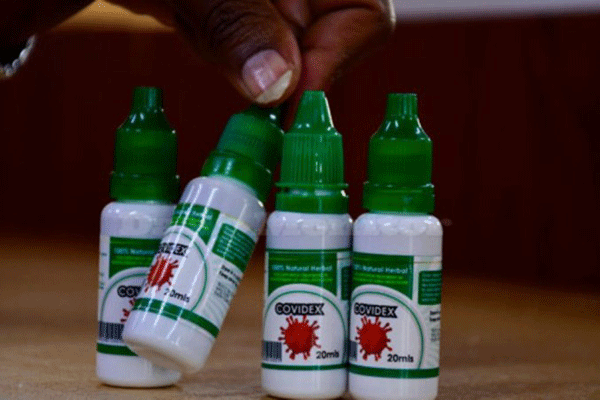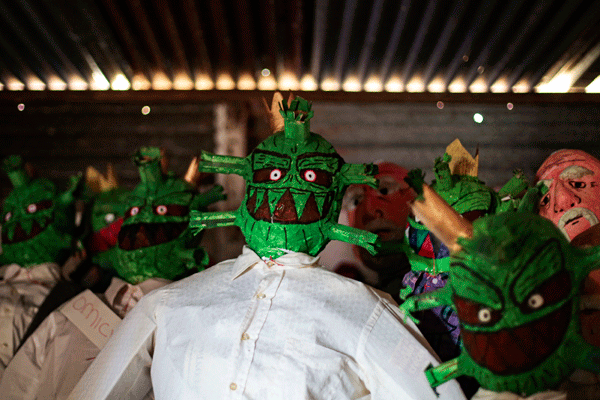Role of traditional medicine in the fight against Covid-19

Covidex is a herbal drug meant as a supplement to other Covid-19 treatments. Many scientists believe that most herbs in traditional cultures are given as part of a whole system of medicine. PHOTO/FILE
What you need to know:
- In the African environment, the therapeutic potential of traditional medicine is enormous and requires further in-depth study.
By Harriet Nakigozi & Dickson Tumuramye
The Covid-19 pandemic has once again shown us that we need a wholesome approach to the delivery of health - highlighting the need for innovation, multisectoral collaboration and the ability to adapt to new normal.
This requires new ways of working, strengthen the way we manage and organise our operations in and around the healthcare sector.
This shall be enhanced through strengthening the ability to work systematically, collaboratively, innovatively, using the evidence towards achieving sustainable health or the 2030 Agenda such as addressing the challenges facing the health sector.
There is increased use of herbal or traditional medicine in the treatment of Covid-19 worldwide but little or limited knowledge is available or known by the people due to wide use of modern medicine.
Traditional medicine
Traditional medicine (TM) is a method of healing having its own concept of health and disease which comprises unscientific knowledge systems that have developed over generations within various societies before the era of western medicine (WM). Knowledge is passed on orally from father to son through generations and is jealously guarded in certain families.
The components of TM are encompassing and include herbal medicine, therapeutic fasting and dieting among others. The practitioners include herbalists, diviners and midwives.
Many traditional medicine practitioners (TMPs) in Africa are people without education, who have rather received knowledge of medicinal plants and their effects on the human body from their forebears as in reference [Bodeker et al., 1994]. They have a deep and personal involvement in the healing process and protect the therapeutic knowledge by keeping it secret.
In a manner similar to western medicinal practice, the practitioners of TM specialise in particular areas of their profession. (Cunningham et al 1997)
According to a documented review, the Inyangas of Swaziland are said to be experts in herbalism, whilst the South African Sangomas are experts in spiritual healing as diviners, and others specialise in a combination of both forms of practice
Modern science has, in the past, considered methods of TM as primitive but little was done to investigate the legitimacy of these practices according to Nahin etal 2001. Consequently, the orthodox health care practitioners have, in most cases, continued to shun TMPs despite their contribution to meeting the basic health needs of the population. For instance, modern pharmaceuticals and medical procedures remain inaccessible to large number of African people due to their relatively high cost and concentration of health centres in urban centres.
TM on the other hand is available and affordable to the ordinary African both in the rural and urban areas. In recent years, the treatments and remedies used in ATM have gained more appreciation from researchers in western science.
The TMPs are now receiving formal training at university level where they currently adopt methods similar to those used by western medicine practitioners (WMPs) to diagnose diseases and administer treatment. The Place of Traditional Medicine in the African Society:
The Science, Acceptance and Support front, developing countries have begun to realise the high costs of modern health care systems and the technologies that are required thus proving Africa’s dependence on TM.
Due to these, interest has recently been expressed in integrating ATM into the continent’s national health care systems. One study explored the relevance of ATM with regard to its science, acceptance and the necessity for its support from the stakeholders while also highlighting steps taken so far by African governments.
Role of traditional medicine in Africa
The importance of TM for people in Africa in the past, now and in the future is enormous. The remedies made from indigenous plants play a crucial role in the health of millions of Africans.
According to the International Development Research Centre (IDRC), one estimate puts the number of Africans who routinely use these services for primary health care as high as 85 percent in Sub-Saharan Africa.
In Ghana, traditional medicine caters for about 75-85 percent of the rural people and 45-65 percent of urban dwellers, while WHO declaration at Beijing in China stated that about 85 percent of people worldwide seek traditional health practitioners as first choice before Western Medicine.
The TMPs have therefore proven to be a large and influential group in primary health care and an integral part of the African culture and are required for the health of its people especially in this Covid-19 era. Given the high cost of medicine manufactured by the western pharmaceutical companies, treatments are not made available widely enough for most Africans.
This may imply that many rural African communities are not able to afford the high price of pharmaceuticals and in some instances, they cannot readily obtain the medicine even if they were affordable; therefore, TMPs remain their only means for medical help.
China, India, Nigeria, the US, and WHO have all made moderate research investments in traditional herbal medicines and industries have also invested some funds looking for promising medicinal herbs and novel chemical compounds.
Non-governmental organisations such as the Association for the Promotion of Traditional Medicine (PROMETRA) in Senegal and the Centre for Scientific Research into Plant Medicine located at Akuapim-Mampong in Ghana have also dedicated to preserving and restoring ATM and indigenous science.
Although these are still relatively modest investments and attempts compared to WM, it shows a promise that at last the scientific community is beginning to pay attention to TM as an alternative or partner to WM.
Uganda is not different from other countries in Africa as most people believe in traditional healers than professional medics with an estimated traditional health practitioner for every 200-400 Ugandans compared to one western- trained doctor per 20,000 as postulated by De Coninck, 2016.
TM takes close to 90 percent of the day-to-day usage in health care needs with big number of people in rural and urban areas depending on herbal medicines for treating a variety of diseases due to its affordability, accessibility and cultural familiarity (Galabuzi et al, 2010).
In the African environment, the therapeutic potential of TM is enormous and requires further indepth study to improve methods and training so as to form a more effective organisation within the ranks of Traditional Medical Practioners.
Many scientists believe that most herbs in traditional cultures are given as part of a whole system of medicine. The known maxim in traditional medical practice is; ‘take this herb and do this exercise and change your diet’ i.e., it is a multidimensional treatment.
In most cases, the administration of TM is a contentious issue particularly in the areas of methods, diagnosis and doses which have made its integration to Western Medical Model a difficult task.
The argument for TMPs on the other hand, lies largely on the lack of sufficient time and research funds to showcase its potentials. Most grants given toward TM research have been for pilot projects which cannot establish the desired definitive assessment of efficacy expected of a robust research.
For TM to respond to the challenge of science and to be accepted by all, there has to be some serious input of funds from governments, agencies and corporate bodies to undertake in-depth research work into its efficacy, safety, quality, standardisation and regulation.
It is no secret that there are often huge variations in the way in which the medicines are used in TM, including herb source, preparation, dose and indication. Also, because TMPs are unregulated professional body coupled with the lack of standardisation in their products, it may be difficult to generalise the results from a formal, structured and highly monitored trial.
Nevertheless, herbal medicine research must be performed to achieve a balance between internal and external validity to bring about standardization in conformity with the WM principles as in [Bot etal., 2003]. It is, however, encouraging that most contemporary TMPs have begun to apply proven standardisation in their work to match the western medical practice. Tremendous improvements have been achieved in the areas of the use of modern equipments that are found in western medical hospitals/clinics, labelling of herbal preparations with required dosages and availability of well trained practitioners with bachelors and masters degrees.
Research
Researchers increasingly agree that it is important to establish a rational basis for dosing and standardisation of biologically active compounds before conducting largescale treatment trials. These efforts can improve the investigators’ ability to assess the risks and benefits of subjects’ participation in large-scale herbal medicine trials according to some scientists.
Likewise, more rigorous monitoring of adverse events and standardised reporting of research results for both safety and efficacy data will improve long-term efforts to enhance risk–benefit ratio determination for trial participants and these are being addressed in traditional herbal research and practice.
However, it is important to establish standards of evidence for demonstration of safety devoid of cultural influence before conducting large-scale clinical trials on which the efficacy of herbal medicines can be evaluated.
Research activities in TM must also be formulated based on challenges as found in WM. This will give a brighter future to this area of research and position TM research to play a critical role in global health.
Addressing the scientific challenges of TM requires collaborative partnerships that implement sound research designs. In fact collaborative partnership which displays a commitment by all parties in international research agreements to work together for common language and goals should be the way forward for ATM research and with sustained investment; it will become increasingly possible to conduct sound international scientific investigation on TM.
Traditional medicine
Traditional medicine takes close to 90 percent of the day-to-day usage in health care needs with big number of people in rural and urban areas depending on herbal medicines for treating a variety of diseases due to its affordability, accessibility and cultural familiarity (Galabuzi et al, 2010).
In the African environment, the therapeutic potential of traditional medicine is enormous and requires further in-depth study to improve methods and training so as to form a more effective organisation within the ranks of Traditional Medical Practioners.
*The writers are researchers with Network for Education and Multidisciplinary Research Africa. Dr Harriet Nakigozi is a Laboratory Scientist and Public Health Specialist –National Health Laboratory and Diagnostic Services/Ministry of Health Uganda. Dickson Tumuramye is a Child advocate and Marriage Counsellor




